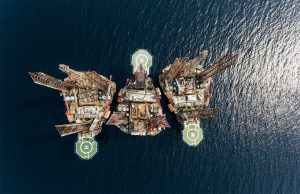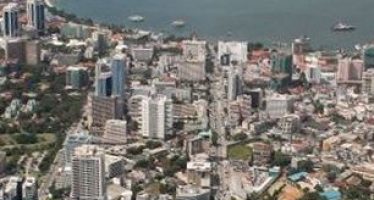Oil North of 60: Africa Seeks to Cash in on Energy Crunch
 Already jittery markets, largely without direction, are braced for a near-perfect storm as central banks taper their bond-buying sprees and shelling across the ‘line of separation’ in Ukraine intensifies – a possible, if not likely, presage to an all-out war on a scale not fought in Europe since World War II.
Already jittery markets, largely without direction, are braced for a near-perfect storm as central banks taper their bond-buying sprees and shelling across the ‘line of separation’ in Ukraine intensifies – a possible, if not likely, presage to an all-out war on a scale not fought in Europe since World War II.
Meanwhile, oil prices, buoyed by a robust post-covid economic recovery, steadily creep north, and are widely expected to break the $100 a barrel barrier before long.
The spot price of crude is but one gauge of heightened – even extreme – market volatility. Just over eighteen months ago, oil producers facing an almost unprecedented slump in demand had to actually pay ‘buyers’ to accept delivery of their crude after storage facilities on land and sea had reached full capacity.
Spooked Investors
OPEC+ member states, plagued by chronic under-investment, currently struggle to restart production shut down in 2020. Most oil supermajors, including US shale drillers, have been focussed on delivering goodies – such as share buybacks and dividends – to (institutional) investors spooked by environmentalist groups. However, by the end of this year, global demand for oil will exceed pre-covid levels by up two million barrels a day.
The global markets for crude, diesel, natural gas, and coal are now exceptionally tight and suffer backwardation – a bullish sign whereby (spot) prices for immediate delivery exceed those for future contracts. “There is not much to give in the system,” says Vitol Group CEO Russell Hardy: “Energy supplies are only arriving just-in-time which is not a great place to be.” Vitol Group is the world’s largest independent oil trader. A nuclear deal with Iran may allow that country to pump an extra million or so barrels a day but, according to Mr Hardy, that extra supply has already been factored in for the second half of the year.
UBS Group commodity analyst Giovanni Staunovo fears that a further escalation of tensions in Eastern Europe may disrupt supplies, either intentionally or because of (geo)political division. That may fuel inflation in the developed world, but also rekindles hope of a windfall elsewhere.
Poking Africa
With oil prices up 70% over the past 12 months, and likely to stay above the $60-a-barrel mark for the foreseeable future in what some analysts consider the beginnings of a supercycle, opportunities open up for marginal producers in Africa to develop recent discoveries off the coast of South Africa and Mozambique where a potential 500 trillion cubic feet of natural gas were identified. Namibia sits on an estimated 11 billion barrels of light oil. Poking around in the Kavango Basin, Canadian oil and gas explorer Reconnaissance Africa thinks the area may hold as much as 120 billion barrels of oil.
In next-door South Africa, the Karoo Basin in the Free State holds some 390 trillion cubic feet of recoverable natural shale gas. However, a recent court order blocking Shell and its local partner Mantashe from conducting seismic surveys off the Wild Coast – hailed by environmental groups – has dampened spirits. Spokesperson for SA Oil and Gas Craig Morkel warned that regulatory weaknesses and legal uncertainties may yet cause South Africa to lose the opportunity to become self-sufficient in energy.
Chairman Nj Ayuk of the Johannesburg-based African Energy Chamber is not at all pleased that the developed world is holding the continent to its clean energy agenda. This makes is harder to secure funding for oil and gas projects that can help lift Africa out of poverty: “Africa contributes just 4% to global greenhouse gas emissions yet is expected to follow the renewables agenda. Natural gas is considered a key component of the green transition and some banks agree with that, but we need more.”
Harmonising Imperatives
Recent discoveries elsewhere on the continent add to the growing unease that the oil and gas bonanza may prove elusive due to investor reluctance. Exploration by, amongst others, Italian energy company Eni has shown that Africa is awash with oil and gas: 2 billion barrels of oil and 1.8 trillion cubic feet of gas off the coast of Côte d’Ivoir; 500 million barrels of oil equivalent off the coast of Ghana; and 250 million barrels of oil in the Angolan Cabaça Development Area.
Both Messrs Ayuk and Morkel agree that the continent’s – and particularly South Africa’s – regulatory framework needs an urgent update to harmonise environmental and developmental imperatives. “If we don’t, we risk losing a great opportunity to transform the country by pursuing energy self-sufficiency,” says Mr Morkel who further notes that the exploitation of onshore reserves is especially interesting given that the costs are 70% rand denominated as opposed to offshore drilling which is invariably priced in US dollars.
You may have an interest in also reading…
Chinua Achebe (1930-2013): A Great Tree Has Fallen
In the mid-20th century Africa was starting once more to find its own voice, having been gagged by centuries of
Orban on Orbán: Cease and Desist, Your Position Is Untenable
Europe’s other ‘Orban’ sounds much more reasonable than the vociferous original one. Prime Minister Ludovic Orban of Romania yesterday chastised
Tanzania Could Create Many New Jobs by Harnessing its Rapid Urban Expansion
Tanzania could create large numbers of new, productive jobs for its people, especially young men and women, if policy makers


















































































